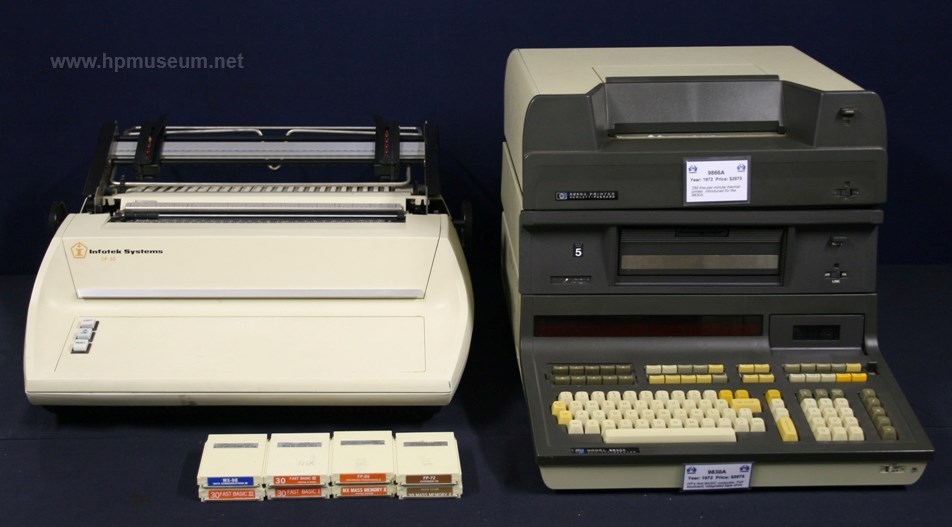Technical Desktops
 CP-30 Printer | Early Calc and Computers Selection: |
| Name: Infotek Systems | |
| Product Number: 1400 N Baxter St, Anaheim Ca | |
| Introduced: 1975 | |
| Ad: 1977, 1982, 1987, 1987, 1987, 1987, 1988, 1989 | |
| Original Price: Unknown | |
| Catalog Reference: Does not appear | |
| Donated by: Adolf Specht, Vancouver BC. Stan Kurzet, Newport Beach California |
Description:
Infotek Systems was a developer of third-party products for HP technical desktop computers. It is well outside the scope of the museum to include a third party company in the collection. However, Infotek was one of the very first companies to provide add ons to HP computers, and its products were truly outstanding. Infotek was founded in 1975 by Stan Kurzet. Stan has been a wonderful benefactor to the HP Computer Museum. For more information on the Infotek story, please visit Steve Leibson's site.
Stan had formed A.L.S. Corporation in 1969 in Covina California. A.L.S. designed and manufactured power conversion equipment. The engineers at A.L.S. used HP technical desktop computers (particularly the 9830) as tools in their work. A.L.S. made enhancements to the computers to add capability and to make them faster (for internal use). Infotek was a division of A.L.S. and was founded when the company decided to sell the internally-developed HP computer enhancements to the general public. The market response was immediate and overwhelming. Infotek opened its European office, Infax GmbH in 1977 (Infotek couldn't use its own name in Europe because of a conflict with the company Kalle Infotek Ltd). Infax was run by Theo Stevens. By 1981, A.L.S. and Infotek employed 194 people.
One of the major benefits provided by the company was that its products integrated seemlessly with the 9830A. A good example of this integration is the Infotek flexible disc system. HP never offered a flexible disc solution for the 9830. Standard mass storage in the 9830 was a very slow and very limited capacity built-in tape drive. Later, HP offered a very expensive hard disc mass storage system for the 9830. Infotek provided an 8-inch floppy disc system for the 9830. The commands used to control the Infotek floppy disc were identical to those used to control HP's built in TAPE DRIVE. Even Infotek's documentation (manuals and promotional literature) were like HP's documentation. Infotek used the same color scheme, layout design, fonts, graphic elements and writing style as HP.
Infotek is also a great illustration of the economics of the computer industry at the time. The company was founded to make accessories for a product three years after that product was introduced. Computers had much longer lifespans in the 1970s. And, all systems were proprietary. This meant that users of computers spent a lot of time and effort developing their systems around a particular hardware platform. Those systems were not easily or cheaply transferred onto new platforms when better and cheaper hardware became available. Infotek made most of its money long after HP stopped investing in the 9830 platform. 9830 installations with Infotek accessories could perform at levels that made migration to 9845 or HP-250 computers generally uneconomic. It wasn't until the introduction of the MC68000 computers in 1981 that started to change the economics of considering migration.
Some Infotek products for the 9830 included:
- LP-30 impact dot matrix line printer ($6850),
- CP-30 daisy wheel character printer ($3400, based on the Diablo HyType II printer),
- FD-30 8" floppy drive ($3895). HP never offered a floppy disc solution for the 9830,
- FD-9830 Dual 8" floppy drive ($4900),
- TC-30 real time clock ($825),
- PS-30 paper tape punch/reader ($3850),
- Fast BASIC ROMs 1 to 5 ($500 to $700). These ROMs provided the 9830 with significant mprovements in speed as well as computational and I/O capability,
- EM-30 increased the memory of the 9830A to 16,096 words ($4900),
- MX-30 fast processor. The MX-30 converted the 9830 from an 8-bit serial processor to a 16-bit parallel processor by replacing all of the internal processor and memory boards. It offered memory capacity up to 64K and made the 9830 a completely new class of computer.
Collector's Notes:
The museum has a very extensive collection of Infotek products. The performance of a 9830 with an Infotek MX-30 fast processor is nothing short of amazing. The MX-30 was a complete redesign and uses only the chasis of the 9830. No HP boards or ROMs were compatible with the MX-30. However, all programs written on a 9830 would run unaltered on the MX-30, but much faster. Only the lack of a large screen prevented the 9830 from having a much longer usable life with Infotek upgrades.
We have found the ongoing reliability of Infotek boards to be about the same as HP boards, with the exception of the M and T registers of the MP-30 and MX-30 processors. As of 2013, these boards had a failure rate of just under fifty percent. Other Infotek boards seem to have a failure rate around 25 percent.
| Back | More Images | Product Documentation | Category Accessories |
^ TOP©2004 - 2025 BGImages Australia - All Rights Reserved.
The HP Computer Museum and BGImages Australia are not affiliated with HP Inc. or with Hewlett Packard Enterprise. Hewlett Packard and the HP logo are trademarks of HP Inc and Hewlett Packard Enterprise. This website is intended solely for research and education purposes.
